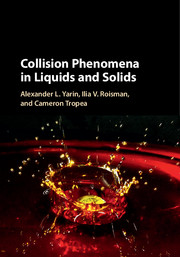Book contents
- Frontmatter
- Contents
- Preface
- 1 Introduction
- 2 Selected Basic Flows and Forces
- Part I Collision of Liquid Jets and Drops with a Dry Solid Wall
- Part II Drop Impacts onto Liquid Surfaces
- Part III Spray Formation and Impact onto Surfaces
- Part IV Collisions of Solid Bodies with Liquid
- Part V Solid–Solid Collisions
- 12 Particle and Long Bar Impact onto a Rigid Wall
- 13 Shaped-charge (Munroe) Jets and Projectile Penetration
- 14 Fragmentation
- Index
- References
13 - Shaped-charge (Munroe) Jets and Projectile Penetration
from Part V - Solid–Solid Collisions
Published online by Cambridge University Press: 13 July 2017
- Frontmatter
- Contents
- Preface
- 1 Introduction
- 2 Selected Basic Flows and Forces
- Part I Collision of Liquid Jets and Drops with a Dry Solid Wall
- Part II Drop Impacts onto Liquid Surfaces
- Part III Spray Formation and Impact onto Surfaces
- Part IV Collisions of Solid Bodies with Liquid
- Part V Solid–Solid Collisions
- 12 Particle and Long Bar Impact onto a Rigid Wall
- 13 Shaped-charge (Munroe) Jets and Projectile Penetration
- 14 Fragmentation
- Index
- References
Summary
The first two sections in the present chapter are devoted to penetration of shaped-charge (Munroe) jets. Shaped-charge jets are characterized by such tremendous stresses that metal flow can be treated in the framework of potential flow hydrodynamics. Section 13.1 is devoted to the elementary theory of penetration depth of a shapedcharge jet perforating an armor, while Section 13.2 describes a detailed structure of the corresponding metal flow and predicts the crater shape using the hodograph method of complex analysis in the planar case. An estimate for an axisymmetric case is also given in this section. Normal penetration of eroding projectiles into elastic–plastic targets is covered in Section 13.3. The limit of high-speed penetration where pressure and the inertial effects are dominant is considered in Section 13.4, and the quasi-steady regime of penetration of an eroding projectile is treated in Section 13.5. Section 13.6 is devoted to description of normal and oblique penetration of rigid projectiles and comparison with numerous experimental data. Explosion welding discussed in Section 13.7 is also characterized by tremendous stresses, while the resulting metal flow is not only “inviscid” but even compressible. Still, the problem can be reduced to the form appropriate for complex analysis, which reveals some important details of the interface formation between two materials welded by this method. The experimental evidence shows some additional fascinating details which deserve a further analysis.
Shaped-charge Jet Penetration Depth
In 1888, Munroe discovered the phenomenon of so-called shaped-charge (or Munroe) jets. Later on, he described it in the following words (Munroe 1900):
“Among the experiments made … was one upon a safe twenty-nine inches cube, with walls four inches and three quarters thick, made up of plates of iron and steel … When a hollow charge of dynamite nine pounds and a half in weight and untamped was detonated on it, a hole three inches in diameter was blown clear through the wall … The hollow cartridge was made by tying the sticks of dynamite around a tin can, the open mouth of the latter being placed downward.”
Information
- Type
- Chapter
- Information
- Collision Phenomena in Liquids and Solids , pp. 515 - 565Publisher: Cambridge University PressPrint publication year: 2017
